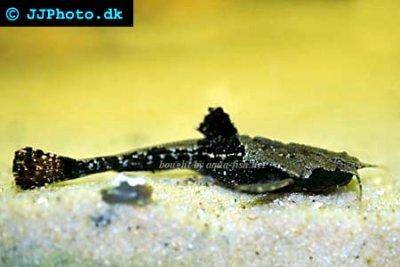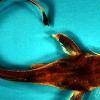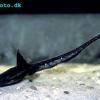Banjo catfish - Bunocephalus coracoideus
Scientific name: Bunocephalus coracoideus
Common name: Banjo catfish
Family: Aspredinidae
Usual size in fish tanks: 12 - 15 cm (4.72 - 5.91 inch)
014
Recommended pH range: 6 - 7.5
Recommended water hardness: 4 - 18°N (71.43 - 321.43ppm)
0°C 32°F30°C 86°F
Recommended temperature range: 24 - 28 °C (75.2 - 82.4°F)
The way how these fish reproduce: Spawning
Where the species comes from: South America
Temperament to its own species: peaceful
Temperament toward other fish species: peaceful
Usual place in the tank: Bottom levels
Short description
The Banjo catfish (Bunocephalus coracoideus) is a cryptic, leaf-litter specialist from South America. Flattened and camouflaged like a twig or dead leaf, it spends long periods buried or motionless on soft sand. It is peaceful, largely nocturnal, and best for calm community setups with gentle flow and dim lighting.
Origin
South America – widespread in lowland drainages of the Amazon and Orinoco basins (Brazil, Peru, Colombia, Venezuela) and nearby systems. Typical habitats are slow, shallow waters with soft substrates, leaf litter, and submerged wood.
Food and feeding
An omnivorous benthic forager that takes small invertebrates and detritus. Provide sinking catfish pellets/wafers, plus small frozen or live foods (bloodworms, blackworms, daphnia, brine shrimp, finely chopped shrimp). Feed mainly after lights out; use modest portions to avoid fouling the substrate. Flakes alone are insufficient.
Sexing
Mature females are typically larger and deeper-bodied; males remain slimmer. External sexing is otherwise subtle.
Breeding
Home-aquarium breeding is rare. Aspredinid catfishes often show unusual reproduction (in several species the eggs are attached to the female’s ventral surface), but reliable, repeatable reports for B. coracoideus in aquaria are lacking. If spawning occurs, keep water pristine, flow gentle, and offer micro foods once fry are free-swimming.
Lifespan
Typically 8–12 years with excellent water quality; longer is possible.
Behavior & compatibility
Very peaceful and shy; mostly inactive by day. May consume very small fish at night if they fit in its mouth, so choose tank mates accordingly (small to medium peaceful characins/rasboras that are too large to be prey, Corydoras, gentle dwarf cichlids). Avoid boisterous or nippy species that disturb the substrate.
Tank requirements
- Tank size: ~80–100 L for a single specimen; larger for groups.
- Substrate: fine sand (essential for safe burying); add ample leaf litter and driftwood.
- Scape & light: shaded, low-flow areas; dim to moderate lighting to encourage natural behavior.
- Water: pH ~6.0–7.5, soft to moderately hard; temperature 24–28 °C.
- Maintenance: excellent hygiene with gentle siphoning of surface detritus; avoid sudden parameter swings.
Plants in the aquarium
Banjo catfish are not plant-eaters and usually ignore live vegetation. Adding hardy plants can help provide shade and cover, making the fish feel more secure. Species like Anubias, Java fern, or floating plants are excellent choices for a dimly lit setup. For more detailed advice, see this guide on aquarium plants.
Care notes
This is a freshwater species. Long-term brackish conditions are not recommended. Because it buries and sits still for long periods, it is easy to overlook—design the aquascape so you can monitor condition and feeding.
Pictures
Bought by aqua-fish.net from jjphoto.dk. One picture was provided by Dado.






 Banjo
Banjo  Banded
Banded